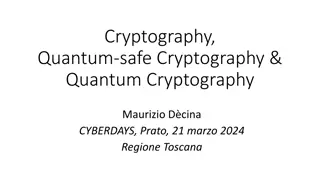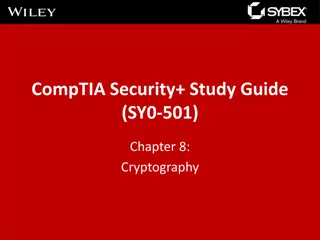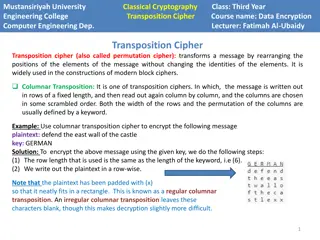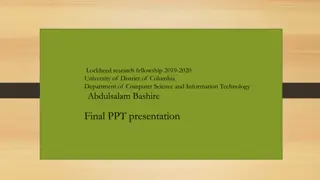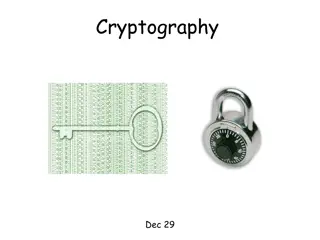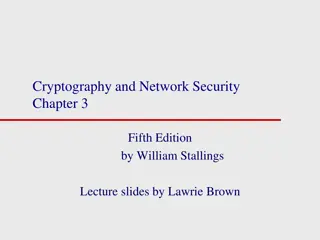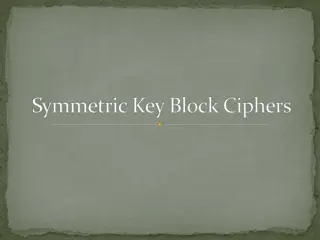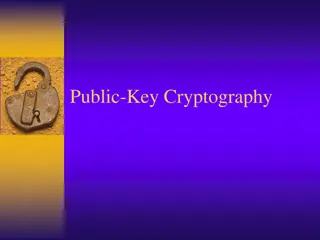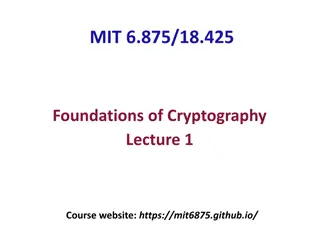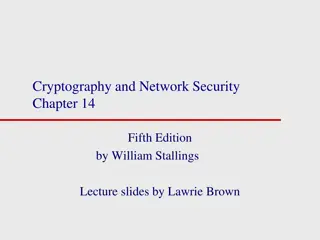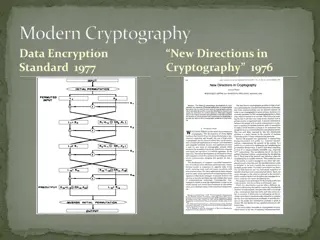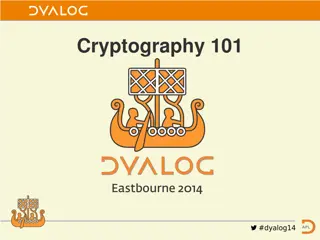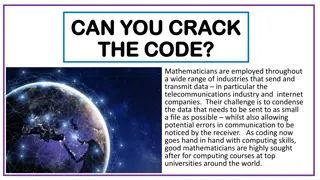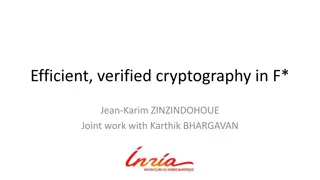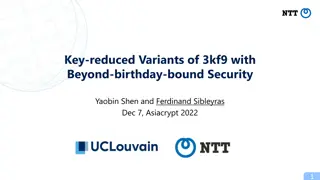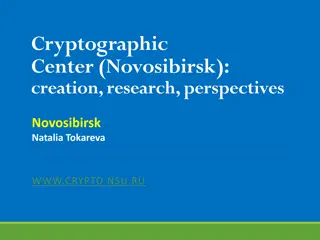Cryptography: Modern Symmetric Ciphers
Explore the world of modern symmetric ciphers used in network security, from encryption basics to advanced techniques like Block vs. Stream Cipher and Autokeyed Vigenere Cipher. Understand the importance of encryption in providing protection for confidentiality, authentication, integrity, and non-repudiation. Delve into the concepts of Block and Stream Ciphers, and learn how encryption and decryption processes work in different cryptographic systems. Discover the encryption methods like Shift, Substitution, Transposition, and Product Ciphers, along with practical examples and insights.
Download Presentation

Please find below an Image/Link to download the presentation.
The content on the website is provided AS IS for your information and personal use only. It may not be sold, licensed, or shared on other websites without obtaining consent from the author.If you encounter any issues during the download, it is possible that the publisher has removed the file from their server.
You are allowed to download the files provided on this website for personal or commercial use, subject to the condition that they are used lawfully. All files are the property of their respective owners.
The content on the website is provided AS IS for your information and personal use only. It may not be sold, licensed, or shared on other websites without obtaining consent from the author.
E N D
Presentation Transcript
Cryptography: Modern Symmetric Ciphers INFSCI 1075: Network Security Spring 2013 Amir Masoumzadeh
Outline Last Week Why encryption? Provides protection Security services - confidentiality, authentication, integrity, non- repudiation Cryptography Shift Cipher (e.g. Caesar or Affine Cipher) Substitution Cipher (e.g. Vigen re ) Transposition / Permutation Cipher Product Cipher This week Block vs. Stream Cipher Modern Conventional Encryption DES, AES 2
Block Ciphers Encrypt data one block at a time Each block of data is encrypted using the same key k Plain text blocks : x1, x2, x3, x4, Ciphertext blocks : y1, y2, y3, y4, y1 = ek(x1); y2 = ek(x2); y3 = ek(x3); k is the same 3
Stream Ciphers Each element, bit or byte is encrypted (e.g. Vigen re) There is a corresponding key stream k1, k2, k3, Plain text: x1, x2, x3, x4, Ciphertext: y1, y2, y3, y4, Key stream: k1, k2, k3, k4, y1 = ek1(x1); y2 = ek2(x2); y3 = ek3(x3); The key stream should be generated in a secure manner from some secret k 4
Autokeyed Vigenere Cipher Shift cipher with a key stream in Z26 Plaintext: x {0,1,2, ,25} Ciphertext: y {0,1,2, ,25} Main Key: k {0,1,2, ,25} Encryption: eki(xi) = xi + ki mod 26 Decryption: dki(yi) = yi ki mod 26 Generation of the key stream ki is simple Use a main key k for the first alphabet Reuse the plaintext as the key for the rest 5
Autokeyed Vigenere Cipher - Encryption Plaintext is FLEE SPEEDILY = [5 11 4 4 18 15 4 4 3 8 11 24] Key for generating the key stream is k = 5 Key stream is generated using the plaintext itself The previous plaintext is the key for the next one Key stream is [5 5 11 4 4 18 15 4 4 3 8 11] Ciphertext = [10 16 15 8 22 7 19 8 7 11 19 9] Ciphertext in alphabet form KQPIWHTIHLTJ Errors can propagate in this case 6
Autokeyed Vigenere Cipher - Decryption Cyphertext was KQPIWHTIHLTJ Use the fact that the first key is k=5 first alphabet is K: leads to 10 5 = 5 = F Alphabet Ciphertext Previous Plaintext Plaintext 2 Q = 16 5 16 5 = 11: L 3 4 5 P = 15 I = 8 W = 22 11 4 4 15 11 = 4: E 8 4 = 4: E 22 4 = 18: S 6 H = 7 18 7 18 = -11 = 26: P 7
Simple Binary Stream Cipher (XOR) ki ki 1 bit or byte 1 bit or byte 1 bit or byte xi yi xi XOR Alice XOR Bob Alice Plaintext 1000001 ASCII A Key stream 0101101 After XOR Ciphertext 1101100 ASCII l Bob Ciphertext 1101100 ASCII l Key stream 0101101 After XOR Plaintext 1000001 ASCII A 8
Linear Feedback Shift Registers (LFSRs) One method of generating the key stream As the name implies, LFSRs are linear If you know the current state, you can predict the next state Linear properties make them easy to break given enough information (2*n plaintext cipher text pairs) Uses a simple XOR to generate key stream XOR the key stream with information to encrypt Starts with a seed or Initial Vector (IV) Have a finite number of states Eventually repeat Have a maximum period (or cycle) of 2n 1 where n is the number of registers Not all LFSRs have the maximum length 9
LFSR - Example Output Feedback 0 1 0 1 0 0 0 1 1 1 1 0 0 1 1 1 1 0 1 0 0 1 1 1 XOR XOR XOR Output Feedback 0 1 1 0 1 0 0 0 1 1 1 1 0 0 1 0 1 1 1 1 0 1 1 0 XOR XOR XOR 11
Modern Conventional Encryption What do we need? (Review) An encryption algorithm that either costs a lot to break or takes a lot of time to break Computational security The cost of breaking the ciphertext exceeds the value of the encrypted information The time required to break the ciphertext exceeds the useful lifetime of the information 12
Goal of Modern Encryption Schemes Oscar can recover the key to the encryption algorithm by brute force search alone and not by any shortcuts The number of possible keys to be tested should be so large as to make brute force search infeasible Example: Data Encryption Standard has 56 bit keys 256 possible keys = 7.2 x 1016 keys If each key attempt took 100ms, a worst case brute force attack would still take 228,493,131 years. 13
Modern Block Ciphers One of the most widely used types of cryptographic algorithms Provide secrecy/authentication services Focus on DES (Data Encryption Standard) to illustrate block cipher design principles 14
Requirements of Modern Block Ciphers Reversible Each ciphertext block should correspond to a unique plaintext block Non-linear Prevent linear analysis that was possible with LFSR Key size Should be of the same order as the plaintext block Efficient Easily implementable Fast encryption and decryption Output should be as random as possible to prevent statistical analysis 15
Modern Block Ciphers 64-bit input 8bits 8bits 8bits 8bits 8bits 8bits 8bits 8bits loop for n rounds T8 T2 T3 T6 T7 T1 T4 T5 8 bits 8 bits 8 bits 8 bits 8 bits 8 bits 8 bits 8 bits 64-bit scrambler 64-bit output One pass through: one input bit affects eight output bits Multiple passes: each input bit affects all output bits Block ciphers: DES, 3DES, AES 16
Data Encryption Standard (DES) Most widely used private key block cipher in the world Adopted in 1977 by NBS (now NIST) as FIPS PUB 46 Encrypts 64-bit data using 56-bit key Has been considerable controversy over its security 64 64 e yi xi 56 17
DES History IBM developed Lucifer cipher by team led by Feistel in late 60 s used 64-bit data blocks with 128-bit key Then redeveloped as a commercial cipher with input from NSA and others In 1973 NBS issued request for proposals for a national cipher standard IBM submitted their revised Lucifer which was eventually accepted as the DES 18
DES Design Controversy Although DES standard is public Was considerable controversy over design in choice of 56-bit key (vs Lucifer 128-bit) and because design criteria were classified! (Totally against Kerckhoff s principle) Subsequent events and public analysis show in fact design was appropriate Use of DES has flourished especially in financial applications still standardized for legacy application use 19
DES Encryption Overview x 64 Initial Permutation 64 64 k1 Round 1 48 32 Bit Swap 56 64 Schedule 64 Key k2 k Round 2 48 Inverse Initial Permutation 64 64 k16 y Round 16 48 21
Initial Permutation (IP) First step of the data computation IP reorders the input data bits Even bits to LH half, odd bits to RH half Example: IP(675a6967 5e5a6b5a) = ? IP Table interpretation Bit 58 will be the 1st bit, bit 50 will be the 2nd bit, etc. 22
Initial Permutation (IP) Example: IP(675a6967 5e5a6b5a) = ?? 1 5 0110 0111 0101 1010 0110 1001 0110 0111 0101 1110 0101 1010 0110 1011 0101 1010 9 13 17 21 25 29 33 37 41 45 49 53 57 64 IP(675a6967 5e5a6b5a) = (ffb2194d 004df6fb) 23
Initial Permutation (IP) and Its Inverse 1 2 22 50 58 64 Initial Permutation (IP) 1 2 22 25 40 64 1 2 22 25 40 64 Inverse Initial Permutation (IP-1) 1 2 22 50 58 64 24
Tables for IP and IP-1 Initial Permutation Inverse of Initial Permutation 25
A Round of DES Li-1e Ri-1e Feistel Structure f ki Lie Rie Lie = Ri-1e Rie = Li-1e [f(Ri-1e, ki)] 26
The function f 32 Ri-1e Expansion Permutation 48 E(Ri-1e) 48 ki E(Ri-1e) ki 48 1 6 7 12 13 18 48 Substitution Boxes 32 B1B2B3B4B5B6B7B8 6 6 6 6 6 6 6 6 S1 S2 S3 S4 S5 S6 S7 S8 Permutation P 4 4 4 4 4 4 4 4 32 27
DES Decryption Decryption must unwind steps of data encryption With Feistel design, Basically, you need to do encryption steps once more using sub keys in reverse order (K16 , K15 , , K1) 28
Avalanche Effect A desirable property of any encryption algorithm A change of one input bit or key bit should result in changing approx half of output bits! Making attempts to guess the key by using different Plaintext Ciphertext pairs should be impossible DES exhibits strong avalanche (Strong advantage) 29
Actual Cases of Breaking DES Electronic Frontier Foundation spent $220,000 to crack DES in 3 days using 1500 chips (July 1998) Searched 90 billion keys per second 22 hours in March 1999 (plaintext was See you in Rome ) @ $250,000 and a distributed effort 30
Strength of DES Time to break DES Number of keys: 256 = 7.2 x 1016 keys On the average you need to search through 255 keys (half of all possible keys must be tried to achieve success.) In the worst case you need to search all 256 keys If you can do one encryption/decryption in 1 clock cycle @ 500 MHz Time taken to check ONE key = 1/(500 x 106) s Time taken to check 255 keys = 255/(500 x 106) s = 72,057,594.04 s /3600 = 20016 hours /24 = 834 days The hertz (symbol: Hz) is defined as the number of cycles per second (MHz = 106 Hz ) Cost to break DES At $20 a chip, to break DES in one day, you need to spend $16,680 31
Example Assume that you have a PC that can do 106 decryption per s. You want to decrypt an algorithm that its key space/key size has 56 bits using brute force approach. So you need to in average check half of the key space. How long does it take to check half of the key space using your PC? ( s = 10-6 seconds) 256 / 2 = 255 different keys to be checked (should be decrypted) In each s you can decrypt 106 ciphertexts using 106 keys out of 255 How many s to decrypt using 255 keys? 255 / 106 = 36028797018.963968 s = 36028797018.963968 *10-6 ~ 36029 sec 36029 sec / 60 ~ 600 min 600 min / 60 ~ 10 hours 32
Key Size (bits) Number of Alternative Keys Time required at 1 decryption/ s Time required at 106 decryptions/ s 232 = 4.3 109 231 s 32 = 35.8 minutes 2.15 milliseconds 256 = 7.2 1016 255 s 56 = 1142 years 10.01 hours 2128 = 3.4 1038 2127 s = 5.4 1024 years 5.4 1018 years 128 2168 = 3.7 1050 2167 s = 5.9 1036 years 5.9 1030 years 168 26! = 4 1026 2 1026 s = 6.4 1012 years 6.4 106 years 26 characters (permutation) 33
Strength of DES (2) Weak Keys Symmetry of bits in the 32 bit halves makes the key weak Roughly 64 weak keys, e.g.: Alternating ones + zeros (0x0101010101010101) Alternating 'F' + 'E' (0xFEFEFEFEFEFEFEFE) '0xE0E0E0E0F1F1F1F1' or '0x1F1F1F1F0E0E0E0E' Number of rounds Six round DES was broken very early on Less than 16 rounds makes DES less secure 34
Strength of DES (3) Complement keys If you replace zeros by ones and ones by zeros, it is called complementing If you have the complement of a key, it will encrypt the complement of a plaintext into the complement of the ciphertext Y=DES(X, K) implies that Y'=DES(X', K') where X' is the bit by bit complementation of X 35
Strength of DES (3) This Reduces key search by half for a chosen plaintext attack (How?) Let s say you have a Plaintext-Ciphertext pair (P, C) for which you want to find the key K You try encrypting P using key K: Y=DES(P, K) If the key K faild (Y C), you can use the complementation property (Y'=DES(P', K') ) to evaluate K' by checking if Y' is equal to C' Therefore you are evaluating two keys (K, K') by only running DES with one key (K), and therefore reduce the number of keys that need to be tried by a factor of 2 from 255 to 254 See Problem 3.13 in the text book 36
Block Cipher Design Basic principles still like Feistel s in 1970 s Number of rounds more is better, exhaustive search will be the best attack then Function f Provides confusion , nonlinearity, avalanche Confusion: Obscures the relationship between the plaintext and ciphertext key schedule Complex sub key creation, goal is to have key avalanche 37
Other Block Ciphers DES is weak because of the key space Brute force attacks are possible Today, you need a cipher with at least a key that is 80 bits long Alternatives are being used in applications today IDEA International Data Encryption Algorithm by James Massey and Xuejia Lai (1990-92) Block size of 64 bits and key size of 128 bits Non-Feistel Included in Pretty Good Privacy (PGP) CAST-128 Feistel (Block size of 64 bits and key size of 128 bits) Blowfish 64 bit blocks, variable key sizes AES 38
Double Encryption Consider double encryption with the shift or affine cipher Is it useful? Do we get any additional security? Why? Why not? Intermediate Ciphertext Plaintext Ciphertext e e x z y k2 k1 39
Triple DES While Advanced Encryption Standard (AES) was being developed, triple DES was used as the de-facto standard What is triple-DES? We shall first look at double DES and the meet-in-the- middle attack 40
Double DES 64 64 64 e e x z y k2 k1 56 56 Question: Does there exist a key k3 such that ek3(x) = y in the case of DES? If yes, any number of stages of DES will be useless Note that DES itself is a product cipher of the elementary round cipher Fortunately, the answer is no, so that we can use multiple stages of DES to provide increased security 41
Meet In The Middle Attack y = ek2(ek1(x)) 256 x 256 = 2112 possible keys However: z = ek1(x) and z = dk2(y) Known Plaintext-Ciphertext Attack ek (x) z(1) z(2) z(3) Key k k(1) k(2) k(3) For each k(i), i = 1,2,3, ,256 Check if dk(i)(y) = any of z(i) k(i) z(i) Worst case effort is 256 + 256 = 257 keys k(2^56) z(2^56) 42
Meet In The Middle Attack Assume you have a known plaintext-ciphertext pair 1- For each key k(1), k(2), , k(256) compute the encrypted value z(1), z(2), , z(256) 2- Store the results in a table 3- Sort the table according to z(.). Why? 4- Decrypt y using the keys k(1), k(2), , k(256) After each decryption, check to see if the decrypted value is in the table The two keys k1 and k2 can be recovered with high probability 43
Triple DES 64 64 64 64 e e e x z w y k2 k3 k1 56 56 56 y = ek3( ek2( ek1(x) ) ) Meet in the middle attack is still possible but we now need ~2112 operations The best attack against triple-DES needs 2108 operations http://citeseerx.ist.psu.edu/viewdoc/summary?doi=10.1.1.41.5608 Triple DES is three times slower than DES 44
Alternative form of Triple-DES 64 64 64 64 e d e x z w y k2 k1 k1 56 56 56 y = ek1( dk2( ek1(x) ) ) Store lesser number of bits for keys (112 instead of 168) 45
Advanced Encryption Standard (AES) Clear replacement for DES was needed had theoretical attacks that could break it have demonstrated exhaustive key search attacks Can use Triple-DES but slow, has small blocks US NIST issued call for ciphers in 1997 15 candidates accepted in Jun 98 5 were shortlisted in Aug-99 Rijndael was selected as the AES in Oct-2000 Issued as FIPS PUB 197 standard in Nov-2001 46
AES Requirements Private key symmetric block cipher 128-bit data, 128/192/256-bit keys Stronger & faster than Triple-DES Active life of 20-30 years Provide full specification & design details Both C & Java implementations NIST have released all submissions & unclassified analyses 47
Rijndael Summary Features Block lengths 128/192/256 bits Key sizes 128/192/256 bits Number of rounds corresponding to key size 10/12/14 For larger block lengths, the number of rounds must be increased This makes any other attack as hard as brute force 128 128 e x y 128/192/256 k 48
AES Basics AES is based on Rijndael The block length is fixed at 128 bits No Feistel structure => all 128 bits of a round are encrypted in that round Smaller number of rounds compared to DES Parameters Key size: Nk in 32-bit words Example: 128 bit key => Four 32-bit words => Nk = 4 Block size: Nb in 32 bit words Number of rounds: Nr Rijndael specifies Nr = 6 + max(Nk, Nb) 49
Evaluation Criteria Security Resistance to cryptanalysis Mathematical foundation Randomness of output bits Relative security compared to competitors Cost Royalty and intellectual property Platform dependence (8 bit to 256 bit architectures) Speed Efficiency Memory requirements 50
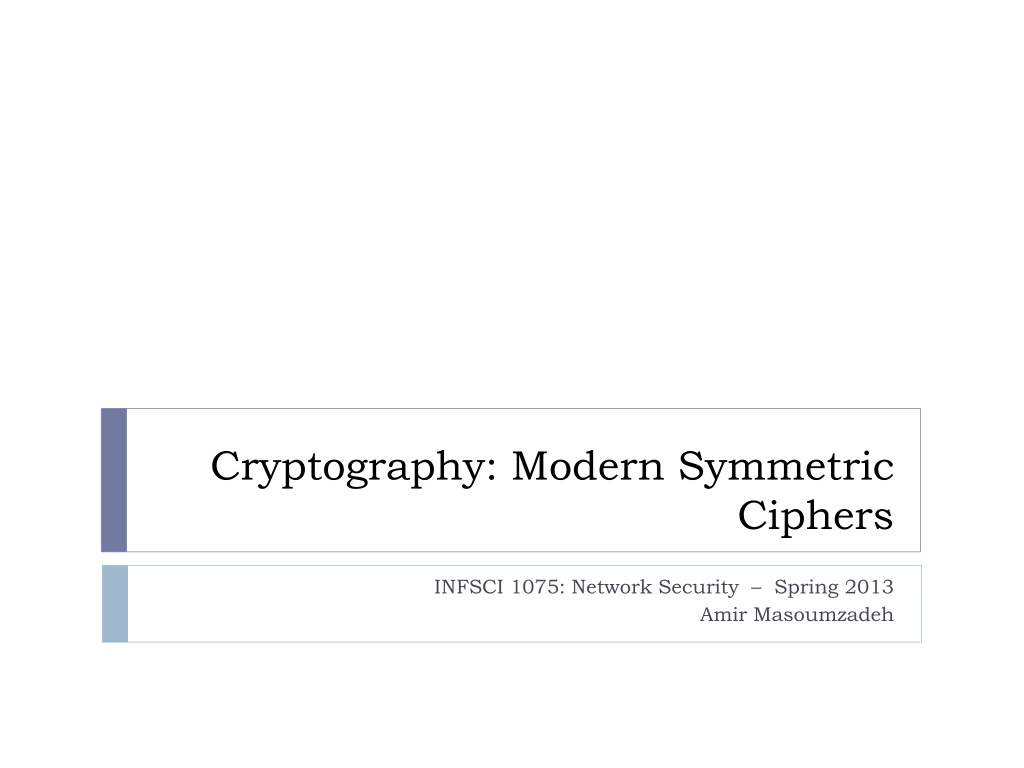
 undefined
undefined








